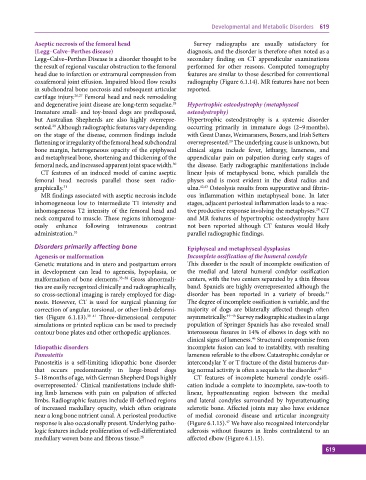Page 629 - Atlas of Small Animal CT and MRI
P. 629
Developmental and Metabolic Disorders 619
Aseptic necrosis of the femoral head Survey radiographs are usually satisfactory for
(Legg–Calve–Perthes disease) diagnosis, and the disorder is therefore often noted as a
Legg–Calve–Perthes Disease is a disorder thought to be secondary finding on CT appendicular examinations
the result of regional vascular obstruction to the femoral performed for other reasons. Computed tomography
head due to infarction or extramural compression from features are similar to those described for conventional
coxafemoral joint effusion. Impaired blood flow results radiography (Figure 6.1.14). MR features have not been
in subchondral bone necrosis and subsequent articular reported.
cartilage injury. 26,27 Femoral head and neck remodeling
and degenerative joint disease are long‐term sequelae. Hypertrophic osteodystrophy (metaphyseal
28
Immature small‐ and toy‐breed dogs are predisposed, osteodystrophy)
but Australian Shepherds are also highly overrepre Hypertrophic osteodystrophy is a systemic disorder
29
sented. Although radiographic features vary depending occurring primarily in immature dogs (2–9 months),
on the stage of the disease, common findings include with Great Danes, Weimaraners, Boxers, and Irish Setters
flattening or irregularity of the femoral head subchondral overrepresented. The underlying cause is unknown, but
29
bone margin, heterogeneous opacity of the epiphyseal clinical signs include fever, lethargy, lameness, and
and metaphyseal bone, shortening and thickening of the appendicular pain on palpation during early stages of
femoral neck, and increased apparent joint space width. 30 the disease. Early radiographic manifestations include
CT features of an induced model of canine aseptic linear lysis of metaphyseal bone, which parallels the
femoral head necrosis parallel those seen radio physes and is most evident in the distal radius and
graphically. 31 ulna. 42,43 Osteolysis results from suppurative and fibrin
MR findings associated with aseptic necrosis include ous inflammation within metaphyseal bone. In later
inhomogeneous low to intermediate T1 intensity and stages, adjacent periosteal inflammation leads to a reac
inhomogeneous T2 intensity of the femoral head and tive productive response involving the metaphyses. CT
28
neck compared to muscle. These regions inhomogene and MR features of hypertrophic osteodystrophy have
ously enhance following intravenous contrast not been reported although CT features would likely
administration. 32 parallel radiographic findings.
Disorders primarily affecting bone Epiphyseal and metaphyseal dysplasias
Agenesis or malformation Incomplete ossification of the humeral condyle
Genetic mutations and in utero and postpartum errors This disorder is the result of incomplete ossification of
in development can lead to agenesis, hypoplasia, or the medial and lateral humeral condylar ossification
malformation of bone elements. 33–38 Gross abnormali centers, with the two centers separated by a thin fibrous
ties are easily recognized clinically and radiographically, band. Spaniels are highly overrepresented although the
44
so cross‐sectional imaging is rarely employed for diag disorder has been reported in a variety of breeds.
nosis. However, CT is used for surgical planning for The degree of incomplete ossification is variable, and the
correction of angular, torsional, or other limb deformi majority of dogs are bilaterally affected though often
ties (Figure 6.1.13). 39–41 Three‐dimensional computer asymmetrically. 44–46 Survey radiographic studies in a large
simulations or printed replicas can be used to precisely population of Springer Spaniels has also revealed small
contour bone plates and other orthopedic appliances. interosseous fissures in 14% of elbows in dogs with no
clinical signs of lameness. Structural compromise from
46
Idiopathic disorders incomplete fusion can lead to instability, with resulting
Panosteitis lameness referable to the elbow. Catastrophic condylar or
Panosteitis is a self‐limiting idiopathic bone disorder intercondylar Y or T fracture of the distal humerus dur
that occurs predominantly in large‐breed dogs ing normal activity is often a sequela to the disorder. 45
5–18 months of age, with German Shepherd Dogs highly CT features of incomplete humeral condyle ossifi
1
overrepresented. Clinical manifestations include shift cation include a complete to incomplete, saw‐tooth to
ing limb lameness with pain on palpation of affected linear, hypoattenuating region between the medial
limbs. Radiographic features include ill‐defined regions and lateral condyles surrounded by hyperattenuating
of increased medullary opacity, which often originate sclerotic bone. Affected joints may also have evidence
near a long bone nutrient canal. A periosteal productive of medial coronoid disease and articular incongruity
response is also occasionally present. Underlying patho (Figure 6.1.15). We have also recognized intercondylar
47
logic features include proliferation of well‐differentiated sclerosis without fissures in limbs contralateral to an
medullary woven bone and fibrous tissue. 28 affected elbow (Figure 6.1.15).
619

